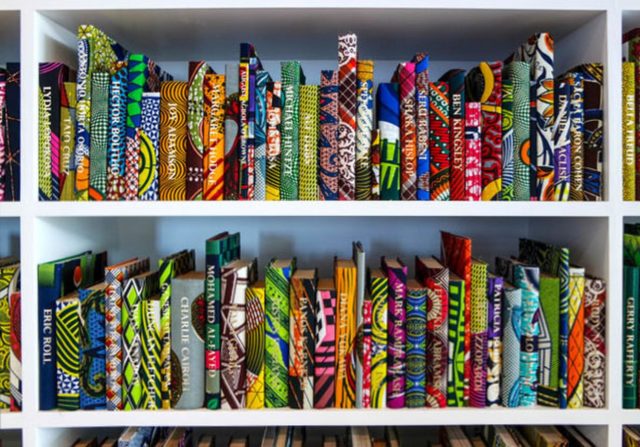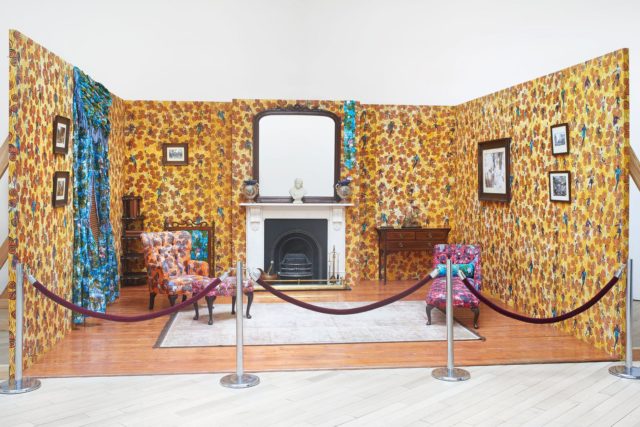
Yinka Shonibare MBE, “The British Library” (2014), hardback books, Dutch wax printed cotton textile, gold foiled names, table with benches, four iPads, iPad stands, headphones, interactive application (Courtesy the artist and James Cohan Gallery, New York; Photo: Phoebe D’Heurle)
Yinka Shonibare MBE: Prejudice At Home: A Parlour, a Library and a Room
James Cohan Gallery
533 West 26th Street
New York, NY
On view until March 18, 2017
Six thousand patterned books line the walls of two rooms at the back of James Cohan Gallery. The spine of each book is emblazoned with names of first and second generation immigrants who have impacted British culture–Christian Bale, Tom Stoppard, Sir Ben Kingsley, Henry James, Yoko Ono, Anish Kapoor, John Galliano and even, rumored “Becky with the good hair” herself, Rita Ora. Basically, it’s your dinner party dream list.
This towering reflection of immigrants’ historical influence comes courtesy of Yinka Shonibare MBE’s installation The British Library, currently on view as a part of his solo show Prejudice at Home: A Parlour, A Library and A Room. With Trump’s travel ban and increased crackdown on undocumented workers, the installation could not have arrived in New York at a more crucial moment. As countless articles attempt to make the case for immigrants and refugees by pointing out foreign-born founders of tech companies or American inventions created by immigrants, Shonibare’s installation achieves what these listicles can’t. It confronts viewers with a tangible, physical record of immigration’s creative impact on a country.
Granted, the exhibition is far from perfect–the first and largest room in the gallery was squandered with the dual display of Shonibare’s photographic series Dorian Gray and his seminal period room installation Victorian Philanthropist’s Parlour. While both address continued tensions of race, wealth and power in postcolonial England, the works just felt underwhelming once viewers entered the all-encompassing timeliness of The British Library. Even though presented in the biggest room, their inclusion still strangely felt like a curatorial after-thought. But, The British Library is such necessary viewing that it renders these flaws irrelevant.

Yinka Shonibare MBE, The Victorian Philanthropist’s Parlour, 1996-1997, Dutch wax printed fabric covered wood, cast iron, brass, marble, mirror, bound printed books, porcelain, glass, framed works on paper, and props (Courtesy the artist and James Cohan Gallery; Photo: Phoebe D’Heurle)
Visitor flow inside the gallery reveals the weakness of these curatorial decisions. When I visited James Cohan, the first gallery was completely desolate. Assuming I was the only person in the space (which wouldn’t have been unusual late afternoon on a Friday), I was startled to discover at least ten people taking photographs, pointing out famous names and spending extensive time in The British Library.
There’s little question why. The installation, with its brightly colored books crammed into two small rooms, feels cozy and encourages extended viewing, as well as a little research. Although a handful of the names on the books are recognizable, even more were not, at least to me. Studying the books, I began randomly Googling names of people I later realized I should have known like political activist Nina Fishman. Not only do the individual names encourage actual learning in the library installation, but Shonibare’s seemingly democratic inclusion of both well-known and less famous individuals portrays just the sheer magnitude of immigrants’ influence. It’s not just the people with the most publicity or accolades that make the greatest mark on a society. Instead, as the installation makes clear, it’s their collective accomplishments that build a country’s character.

Yinka Shonibare MBE, “The British Library” (2014), hardback books, Dutch wax printed cotton textile, gold foiled names, table with benches, four iPads, iPad stands, headphones, interactive application (Courtesy the artist and James Cohan Gallery, New York; Photo: Phoebe D’Heurle)
Even the textiles used to cover the books symbolize an amalgamation of cultures. After some Internet digging, the cloth is Dutch wax printed fabric, which frequently appears in Shonibare’s work. Although it looks like quintessential African design, it is inspired by Indonesian patterns. Mass-produced by the Dutch while Indonesia was still under Dutch colonial rule in the 19th century, this fabric was, then, resold back to West Africa where it became later associated with traditional African aesthetics. Like the names on the books themselves, Shonibare’s chosen fabric mirrors the hodgepodge of cultures that, in fact, make up a country’s heritage.
Originally created for the Brighton Festival in 2014, The British Library is U.K.-focused, and with the passing of Brexit, even more relevant as a response to the increased xenophobia in Britain. But, there’s no way to view the installation in its New York incarnation without thinking of America’s own troublesome contemporary rejection of immigrants and refugees. Shonibare further emphasizes this connection on iPads placed on a wooden table in the center of the installation. Besides featuring the full list of names in the physical installation, the iPads also host a number of American talking heads and politicians on immigration including Obama, Trump and Ann Coulter. Viewers can record their own stories about immigration, thus participating in the art work.
Admittedly, The British Library is quite literal. At a less dire political time, the installation might read to me as a cheesy Public Service Announcement cloaked in an art installation. However, with America’s values currently under question, it seems like art viewers and citizens need to be reminded of the cultural importance of immigrants, not to mention what we might lose without them.


Comments on this entry are closed.